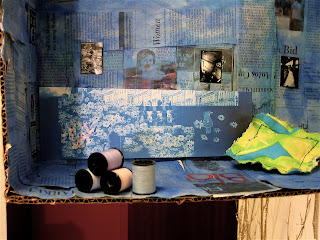Early fall, this evolved into the sliced Granny Smith being slathered with cinnamon-raisin peanut butter and sprinkling it with dried cranberries. Awesome!
Late fall, I completely jumped off the tracks with the discovery of a bacon and chocolate candy bar. The bar is made by Vosges, creators of haut chocolate. They call it "Mo's Bacon Bar." It's a combination of smoked bacon, sea salt and deep milk chocolate. Genius!!! I was munching on it in class with someone, and we both agreed it could use some puffed rice.
Actually, we said Rice Krispies. But, a company that describes their product as "haut" probably shuns ingredients hawked by three elves. So I came up with this idea of making Rice Krispie cupcakes topped off by a bacon-chocolate frosting. With tiny bits of bacon sprinkled on top. I was preparing to make this masterpiece...
BUT THEN CAME THANKSGIVING.
My family is so invested in Thanksgiving, we have pre-Thanksgiving meals to warm up for the big feast.
pre-Thanksgiving meals
World Famous Sloppy Joes
"the slurps heard 'round the world!"
Butternut Chutney
butternut chunks
chopped bell peppers [yellow, green, red]
carmelized onions
dried cranberries
peach, pineapple, & tomato salsa
Saute, serve in wraps & laissez les bon temps roulez, cher!
Practice Pies
"duplicates that are taste-tested to ensure
no nasty surprises await on the BIG DAY"
blueberry
pumpkin
Thanksgiving Meal
Tom Turkey
stuffing
mashed potatoes
green bean casserole
cranberry sauce (fresh, not canned)
buttermilk biscuits
drop biscuits
gravy
pumpkin pie
cherry pie
vanilla ice cream
whipped cream
My mom makes enough stuffing to feed a platoon of Marines. In my refrigerator, I have one casserole dish chock full of stuffing, a doggie-bag wrapped bundle of stuffing, and three 1-gallon bags bursting with stuffing. Other people descended on Tom Turkey like carrion birds, the biscuits were gone by breakfast the next morning, and the green beans & mashed potatoes were magically whisked away by somebody. Everybody gets gravy. We regard gravy like Telly Savalas regards moolah in Vegas: "When I got it, baby, everybody's got it!" But, the stuffing is mine. You want it, you gotta bleed for it.
I'm so happy every time I come home because it's time to heat up stuffing, which I roll up in a wrap with chilled cranberry sauce. Hurts so good!!!
World Famous Sloppy Joes
"the slurps heard 'round the world!"
Butternut Chutney
butternut chunks
chopped bell peppers [yellow, green, red]
carmelized onions
dried cranberries
peach, pineapple, & tomato salsa
Saute, serve in wraps & laissez les bon temps roulez, cher!
Practice Pies
"duplicates that are taste-tested to ensure
no nasty surprises await on the BIG DAY"
blueberry
pumpkin
Thanksgiving Meal
Tom Turkey
stuffing
mashed potatoes
green bean casserole
cranberry sauce (fresh, not canned)
buttermilk biscuits
drop biscuits
gravy
pumpkin pie
cherry pie
vanilla ice cream
whipped cream
My mom makes enough stuffing to feed a platoon of Marines. In my refrigerator, I have one casserole dish chock full of stuffing, a doggie-bag wrapped bundle of stuffing, and three 1-gallon bags bursting with stuffing. Other people descended on Tom Turkey like carrion birds, the biscuits were gone by breakfast the next morning, and the green beans & mashed potatoes were magically whisked away by somebody. Everybody gets gravy. We regard gravy like Telly Savalas regards moolah in Vegas: "When I got it, baby, everybody's got it!" But, the stuffing is mine. You want it, you gotta bleed for it.
I'm so happy every time I come home because it's time to heat up stuffing, which I roll up in a wrap with chilled cranberry sauce. Hurts so good!!!




































